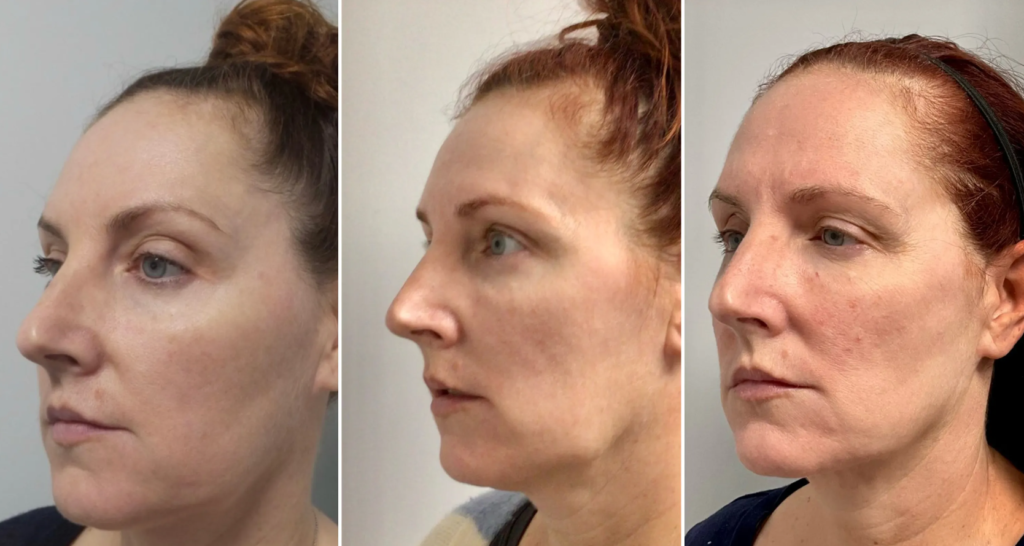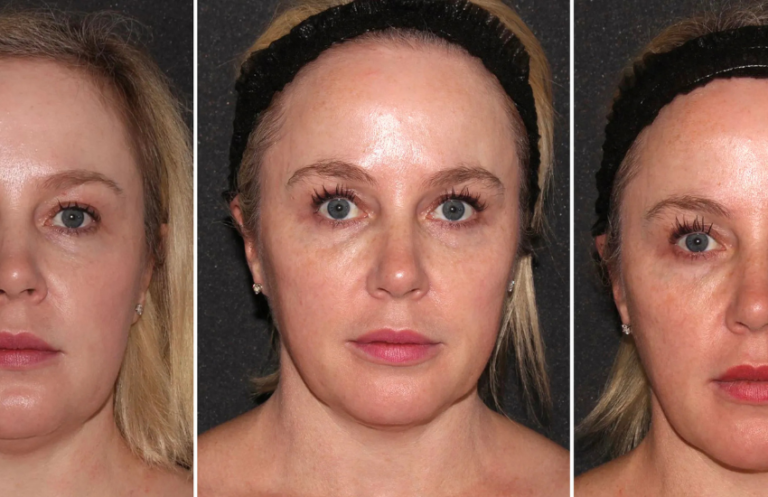As weight loss medications like Ozempic gain popularity for helping individuals shed unwanted pounds, a new aesthetic concern has emerged: “Ozempic face.” This term describes the gaunt, hollowed-out appearance some patients experience after significant weight loss, particularly in the facial area. While Ozempic is widely recognized for its effectiveness in weight management, the side effect of rapid fat loss can leave the face looking older, sagging, and depleted of volume. As more people turn to Ozempic for weight loss, plastic surgeons have seen an increase in patients seeking remedies for Ozempic face.
Fortunately, modern cosmetic procedures offer several solutions to restore the facial fullness lost during weight loss. Plastic surgeons specialize in addressing Ozempic face by using a variety of non-invasive and surgical treatments designed to rejuvenate and enhance facial volume, ensuring that individuals not only achieve their ideal body weight but also maintain a youthful, refreshed facial appearance.
Plastic Surgeons and Ozempic Face: Understanding the Basics
| Term | Details |
|---|---|
| Ozempic Face | A term describing hollowed, gaunt facial appearance after weight loss from Ozempic use |
| Cause | Rapid fat loss in the face, leading to sagging skin and volume loss |
| Common Concerns | Hollow cheeks, loss of facial volume, sagging skin, wrinkles |
| Treatments | Dermal fillers, fat transfer, facelift, non-invasive skin tightening |
| Consultation | Personalized treatment plans with board-certified plastic surgeons |
What is Ozempic Face?
Ozempic, a medication commonly prescribed for managing type 2 diabetes, has gained significant popularity as an off-label option for weight loss. The drug helps individuals control their blood sugar levels and lose weight by suppressing appetite and slowing down digestion. While weight loss is a desired outcome for many, it can have unintended consequences on facial appearance. The phenomenon known as Ozempic face refers to the facial volume loss and sagging that occur when individuals lose fat rapidly, particularly in the cheeks, jawline, and under the eyes.

Fat naturally gives the face a youthful, full appearance. As people age, fat tends to shrink and shift, leading to common signs of aging such as hollow cheeks and deep folds. Weight loss, especially when it happens quickly, can exacerbate this process, making the face appear older than it should, even if the rest of the body looks leaner and more toned. Ozempic face highlights these issues, as patients often notice that their faces look hollowed, tired, or even gaunt after shedding pounds with the help of the drug.
Why Rapid Weight Loss Affects Facial Volume
The face, like other parts of the body, holds fat deposits that contribute to a smooth, youthful appearance. While weight loss can be transformative for body composition and overall health, it often has a more noticeable effect on the face. As fat is lost, skin can become loose and sag due to the lack of underlying support. This issue is compounded for those who lose a significant amount of weight quickly or who are older and have less collagen and elastin, the proteins responsible for skin’s firmness and elasticity.

When fat is lost in the face, areas such as the cheeks, temples, and jawline can look deflated. The skin, now without its fat support structure, can droop or sag, which can make a person appear older or more tired than they feel. This can be particularly concerning for those who’ve worked hard to achieve their weight loss goals but are now faced with a new cosmetic challenge.
How Plastic Surgeons Address Ozempic Face
Many patients who experience the unwanted effects of Ozempic face turn to plastic surgeons for solutions. With a range of advanced treatments and techniques, plastic surgeons are well-equipped to address facial volume loss and restore a more youthful appearance. Below are the most common approaches plastic surgeons use to treat Ozempic face:
1. Dermal Fillers: Restoring Lost Volume
One of the most popular and minimally invasive treatments for Ozempic face is the use of dermal fillers. Dermal fillers, particularly those made from hyaluronic acid (such as Juvéderm or Restylane), are injected into areas of the face that have lost volume. These fillers help plump up the skin, smooth out wrinkles, and restore a youthful appearance.
Fillers are particularly effective in treating hollow cheeks, sunken temples, and the nasolabial folds (the lines that run from the sides of the nose to the corners of the mouth). The results are immediate, and the procedure requires little to no downtime, making it a convenient option for those looking for quick, non-surgical solutions.
Advantages of Dermal Fillers:
- Minimally invasive
- Immediate results
- Little to no downtime
- Natural-looking volume restoration
Fillers typically last anywhere from 6 to 18 months, depending on the type of filler used and the area treated. Patients seeking long-term solutions may need to schedule follow-up treatments to maintain the results.
2. Fat Transfer: A Natural Approach to Volume Restoration
Another option for addressing Ozempic face is fat transfer, also known as fat grafting. In this procedure, fat is harvested from another area of the patient’s body (such as the abdomen or thighs) and is purified before being injected into areas of the face that have lost volume. This technique provides a more permanent solution compared to dermal fillers and uses the patient’s own fat, reducing the risk of allergic reactions or complications.

Fat transfer is particularly effective for patients who want a natural approach to restoring facial volume. It can be used to plump the cheeks, fill in hollow temples, and smooth out wrinkles around the mouth and eyes. The results are long-lasting, and because the procedure uses the patient’s own fat, it feels natural.
Advantages of Fat Transfer:
- Long-lasting results
- Uses the patient’s own fat (natural look and feel)
- Permanent improvement with less need for follow-up procedures
3. Facelift: Surgical Option for Comprehensive Rejuvenation
For patients who have significant skin laxity and volume loss, a surgical facelift may be the best option. A facelift involves tightening the underlying muscles and repositioning the skin to create a more lifted, youthful appearance. In many cases, a facelift can be combined with fat transfer or dermal fillers to address both skin laxity and volume loss.
While a facelift is more invasive than fillers or fat transfer, it offers long-lasting, dramatic results. Patients who opt for a facelift to address Ozempic face typically see a significant improvement in sagging skin, deep wrinkles, and overall facial contour.
Advantages of a Facelift:
- Long-lasting, dramatic results
- Addresses both skin laxity and volume loss
- Can be combined with other procedures for optimal results
4. Non-Invasive Skin Tightening Treatments
For patients with mild to moderate skin laxity but who are not ready for surgery, non-invasive skin tightening treatments like Ultherapy or radiofrequency (RF) treatments offer a good alternative. These treatments use ultrasound or radiofrequency energy to stimulate collagen production deep within the skin, tightening and firming the treated areas over time.
Non-invasive treatments are ideal for patients looking for subtle improvements without the downtime associated with surgery. They are commonly used in combination with dermal fillers to provide both tightening and volume restoration for a more comprehensive rejuvenation.
Advantages of Non-Invasive Skin Tightening:
- No downtime
- Gradual, natural-looking improvements
- Can be combined with fillers or fat transfer for enhanced results
Consulting with a Plastic Surgeon: Personalized Treatment Plans
When considering treatments for Ozempic face, it’s important to consult with a board-certified plastic surgeon who can assess your individual needs and recommend the most appropriate treatment options. Every face is unique, and a personalized treatment plan will take into account factors such as the degree of volume loss, skin quality, and overall health.
Plastic surgeons often use a combination of treatments to achieve the best results, tailoring the approach to each patient’s goals. Whether it’s dermal fillers for subtle volume restoration or a facelift for more dramatic results, consulting with an experienced plastic surgeon ensures that the treatment is safe, effective, and aligned with the patient’s expectations.

Conclusion: Aesthetic Solutions for Addressing Ozempic Face
As more people turn to medications like Ozempic for weight loss, the phenomenon of Ozempic face has become an increasing concern for patients. However, thanks to the expertise of plastic surgeons, there are multiple solutions available to restore facial volume, smooth out sagging skin, and rejuvenate a patient’s overall appearance. From dermal fillers to fat transfer and surgical facelifts, these treatments provide personalized options to help individuals achieve both their body and facial aesthetic goals. With the right care, patients can enjoy the benefits of their weight loss journey while maintaining a youthful, refreshed look.
